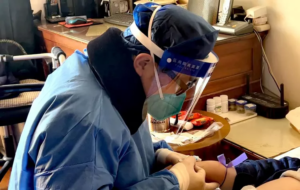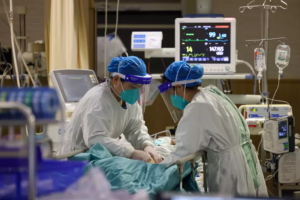
Rural areas meet epidemic prevention test: drug shortage returns to the countryside, some township health centers recruit students as volunteers
“The oral medicine (to reduce fever) is gone, only the injections are left.” On Dec. 25, in Zhaotong, Yunnan, a township health center was going through the most difficult period of the epidemic. For the past week, more than a hundred people have been coming to the fever clinic almost every day, and patients who can’t get the medicine have to find their own way to get fever-reducing medication.
The shortage of fever-reducing medication is also testing rural health centers in many other rural areas of China. Although the Chinese New Year homecoming has not yet arrived, some workers and college students have already returned home. The sudden increase in the number of infections, combined with the shortage of medications and the large number of health care infections, has put the health care system in rural areas under several times the usual pressure.
Recently, the State Council joint prevention and control mechanism press conference said, to focus on strengthening the prevention and control of epidemics and health services in rural areas, the township health center fever clinic to “should be set up as much as possible” “should be open as much as possible”, the village health room to do a good job of prescribing drugs and follow-up services.
There are also rural areas where township health centers have been hit by a wave of epidemics and are preparing for the upcoming Spring Festival homecoming. Some experts point out that rural areas may face many challenges in fighting the epidemic due to the lack of medical resources and other factors.
Health center runs out of stock of antipyretics
Li Xin is the director of a township health center in Zhaotong’s Yongshan County, Yunnan Province. Her health center has about 40 health care professionals and serves a township population of nearly 40,000. In the past week, the hospital has had more than a hundred people visit the fever clinic almost every day, compared to the usual double-digit number.
Like the patients who come to the clinic, most of the health care workers are infected with the new coronavirus, and only one or two dozen are currently on duty. In addition to maintaining normal medical services at the hospital, these staff members must also attend to the steeply multiplying number of patients at the fever clinic.
And the difficulties facing the health center go far beyond that. “Currently there are no more oral medicines (to reduce fever), only injections are left.” On Dec. 25, Li Xin told the Extreme News reporter that the current stock of oral medication used to treat fever and cold in the health center has run out, and patients infected with the new crown but with mild symptoms can only find their own channels to buy medication. Li Xin said that the relevant departments of the county government are trying their best to coordinate drugs for them.
The company’s main business is to provide a wide range of products and services to the public.
The director Tan Jie told the news reporter, because the western medicine fever medicine reserves are tight, the hospital will now give priority to the patient to prescribe fever detoxification of Chinese medicine, the good thing is that the reserves of Chinese medicine is still enough to use. If patients ask for western medicine, the hospital will only prescribe a 3-day supply. Tan Jie expects that even with such intense use of western medicine, the existing stock will only last for 7 days.
Infections have also been on the rise in Linquan County, Fuyang, Anhui province, since around Dec. 10. from Dec. 10 to 15, a local township health center’s fever clinic received nearly 100 patients a day, the highest number of days since the fever clinic opened in 2021. Most of these people are young and middle-aged groups such as returning college students, and 50-60% of those tested positive for new crown by antigen at the hospital, hospital director Wang Yi told Polar News.

Village doctor Lin Wan (a pseudonym) is delivering medicine to villagers
The health center temporarily recruited college students to help
Lin Wan is a village doctor in Linquan County. His village health office has three village doctors. Around December 10, college students returned home one after another, and the pressure of local epidemic prevention increased because of the epidemic prevention work, Lin Wan and a colleague were infected with the new crown virus. Lin Wan said that during that time the village people were going to the town health center to see the fever.
Hu Lin, director of the health center in Lin Wan’s township, told Polar News that around December 10, the pressure on the fever clinic became greater. In the case of a large number of health care workers being infected, the health center had to arrange for health care workers with less severe infection symptoms to also participate in the duty.
In addition to the daily on-call work, the medical and nursing staff had to keep in touch with local elderly people over 65 years old with underlying diseases, and from time to time, they had to understand the physical condition of the elderly and whether they were infected with new crowns.
In Licheng County, Changzhi, Shanxi Province, a township health center had only a dozen medical and nursing staff on duty and could not maintain a fever clinic. The director said that antipyretic drugs are very short, and currently they can only split the antipyretic drugs to prescribe to patients to try to maintain some more time, “I do not know how to do when they run out.”
Tan Jie’s health center originally had 47 medical and nursing staff, and currently only 20 people can stay on duty. In order to alleviate the shortage of medical staff, the health center has issued a notice for returning college students to recruit volunteers to help in the health center.
Stockpiling drugs to cope with the Spring Festival homecoming
Lin Wan’s village has a population of more than 6,000 people, about half of whom are working outside the country. During the upcoming New Year’s Day and Spring Festival holidays, these people will return to their home villages one after another. During regular visits to villagers with underlying illnesses who work outside the village, Lin Wan learned that most of these people have already been treated for the new coronavirus that they contracted at their work sites.
Lin Wan said the government is giving the village elderly a fourth vaccination, and he feels much less pressure to prevent the disease in the Spring Festival.
Starting Dec. 23, the local government began giving fever-reducing drugs to people over 65 years of age, “more than 500 elderly people in the village, four tablets of ibuprofen each.” Lin Wan said that the local government may continue to give the villagers medicine at a later stage.
Wang Yi told the Extreme News reporter that after half a month, the local epidemic situation has eased, the fever clinic at the health center has seen a drop in patients from nearly a hundred a day to 20 or 30, mainly elderly people coming to see the doctor. This makes him less stressed.
Wang Yi’s township has a household population of more than 40,000 people, long-term local life of about 15,000 people, according to his understanding, will return home during the holidays also about 15,000 people, “that is to say, almost 30,000 people during the New Year.” Wang Yi said that the health center is currently stocking drugs according to this number, mainly antipyretic drugs. Because most of the foreign workers have already been infected with the new coronavirus in the field, Wang Yi said there will not be much worry about the upcoming Spring Festival holiday.
Rural areas face many challenges in fighting the epidemic
According to China Newsweek, according to the National Health Commission data, by the end of 2021, there were nearly 980,000 primary health care institutions, including 35,000 township health centers and 599,000 village health rooms. With county hospitals as the center, township health centers as the hub and village health offices (clinics) as the foundation, the country constitutes a three-tier health care network in rural areas. Whether the primary health institutions can fully play their role will determine whether the rural areas can minimize the rate of serious illness and death, and achieve a smooth transition under the first wave of the epidemic after the release of the “New Article 10”.
Peng Jier, deputy director of the Center for Infectious Diseases and Liver Diseases and director of the Center for Difficult Infections at Southern Hospital of Southern Medical University, said in an interview that rural areas may face many challenges in fighting the epidemic due to the large number of elderly people and children in rural areas, the lack of medical resources and poor awareness of scientific treatment. Lv Dewen, a researcher at the China Rural Governance Research Center of Wuhan University, pointed out in an interview that one unpredictable aspect of rural epidemic prevention now lies in the fact that the rural population is more aged and vulnerable, and the rate of serious illness may be higher, so there may be an impact on medical resources.
Nie Chunlei, director of the Department of Primary Health Care of the National Health and Wellness Commission, said at a press conference on the State Council’s joint prevention and control mechanism that the new situation poses new requirements and challenges for primary health care institutions. In order to enhance the response capacity of the grassroots, the main focus is on the following aspects: First, the joint prevention and control mechanism in each region should effectively play a role in mobilizing all parties to support the community and primary health care institutions to carry out their work and form a joint force for the prevention and control of the epidemic. Secondly, equip primary health care institutions with the necessary equipment and increase the provision of essential drugs and antigens for primary health care institutions. Third, to effectively increase manpower at the grassroots level, in the short term, through the second and third level hospitals to send grassroots, recruit retired medical personnel within the last five years, as well as to fill the primary health care institutions with health professionals and technicians in other positions. At the same time, we must effectively play the role of family doctors, and promote the full coverage of key groups of people signed up to ensure that the family doctor can be contacted when the need arises. Fourth, actively play the role of the leading hospital of the medical community of the medical association, to strengthen the technical guidance of the construction and operation of the fever clinic (outpatient clinic) of its members. Coordinate the deployment of personnel within the medical community, smooth two-way referral channels, and strengthen technical support, training, guidance and quality control for the grassroots.


Average Rating